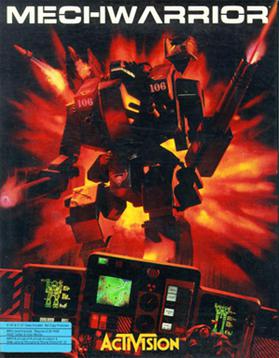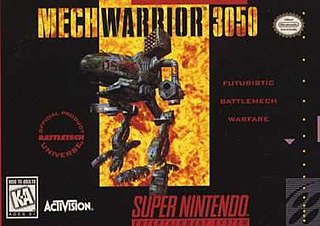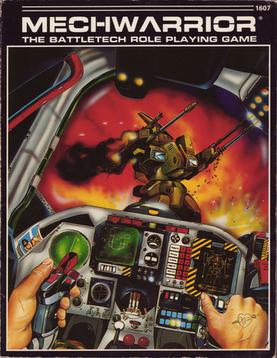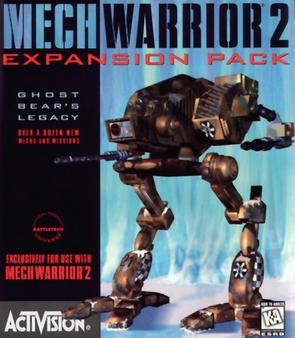BattleTech is a wargaming and military science fiction franchise launched by FASA Corporation in 1984, acquired by WizKids in 2001, which was in turn acquired by Topps in 2003; and published since 2007 by Catalyst Game Labs. The trademark is currently owned by Topps and, for video games, Microsoft's Xbox Game Studios; Catalyst Game Studios licenses the franchise from Topps.
Classic BattleTech is a table-top wargame set in the fictional BattleTech universe that simulates combat between futuristic mechanized forces. Originally published by FASA Corporation, the game is now produced by Catalyst Game Labs under license from WizKids. The term "Classic" is used to differentiate the original game from variants and related games that have derived from it, such as MechWarrior: Dark Age. The game has an extensive range of 1/285 scale miniatures.
Multiplayer BattleTech: Solaris is a version of the multiplayer BattleTech computer game which was available on AOL, and on Kesmai's game service between 1996 and 2001. At its height on the AOL server, thousands of players competed simultaneously in arenas of two to eight participants, battling in team games or free-for-alls. After AOL initiated its hourly pay-for-play system, the majority of players moved to the GameStorm service, which operated for a number of years until its purchase by Electronic Arts.
MechWarrior: Dark Age was a tabletop wargame by WizKids set in the BattleTech universe that uses the Clix system. The game's miniatures are pre-painted models of infantry squads, vehicles, and giant walking war machines known as BattleMechs or more simply "'mechs".

MechWarrior is the second video game released in the BattleTech game series. MechWarrior was the first video game to offer the player a chance to pilot a BattleMech from the view of a pilot. With this game the player has a great deal of freedom when compared to many of the follow-up MechWarrior games, which include choosing missions, buying & selling mechs and parts, hiring lance-mates, and traveling throughout the Inner Sphere. Underneath the major game mechanics, the player had the option of following a role playing style story arc that would unfold over five in-game years.

Mechwarrior 4: Mercenaries is a vehicle simulation video game for Microsoft Windows, released in 2002. It is a standalone expansion of MechWarrior 4: Vengeance, based on the BattleTechMechWarrior game universe.

BattleTech: The Crescent Hawks' Revenge is a real-time tactics game based in the FASA BattleTech universe. It is a direct sequel to BattleTech: The Crescent Hawk's Inception, though the gameplay is considerably different from that of the first title, which was primarily an adventure/role-playing game. Developed by Westwood Associates for Mediagenic, and produced by Scott Berfield, the game serves as a prototype for what later became Dune II, the first real-time strategy title on the PC.

MechWarrior 3050, also known as BattleTech in its original Sega Genesis release and in Japan as BattleTech 3050 (バトルテック3050), is a 1994 mech-based video game developed by Malibu. The first BattleTech based game to be released for the Sega Genesis, it was later ported to the Super Nintendo by Activision as MechWarrior 3050. The Super Nintendo game was localized and published in Japan by Ask Group.
BattleTech Centers are commercial virtual entertainment venues that feature multiplayer virtual combat in the fictional BattleTech universe. The games are played in fully enclosed cockpits with multiple screens, joysticks, and rudder pedals. Today, the gaming cockpits can now be found in various sites around the United States.

MechWarrior 2: Mercenaries is a video game released in September 1996 as a stand-alone expansion to MechWarrior 2: 31st Century Combat and the last BattleTech game made by Activision. In this game, the player takes control of an Inner Sphere mercenary squad, with control over finances and free choice of missions.

MechWarrior is a set of role-playing game rules published by FASA Corporation in 1986 that were designed to be used with FASA's previously published mecha wargame BattleTech.

MechWarrior 2: Ghost Bear's Legacy is an expansion pack to MechWarrior 2: 31st Century Combat.

MechWarrior Online is a free-to-play vehicle simulation video game, officially launched during September 2013 by Piranha Games for Microsoft Windows. The game takes place within the larger BattleTech universe.

Zoids: The Battle Begins is a 1986 video game designed by Chris Fayers, developed by the Electric Pencil Company, and published by Martech. and released in Europe for the ZX Spectrum, Amstrad CPC, MSX and Commodore 64 computers. Based on the Zoids toy series, the player controls a human who was fused with one of the robots and has to reclaim parts of a larger mech.

BattleTech is a Mecha turn-based strategy video game developed by Harebrained Schemes and published by Paradox Interactive. It was released on macOS and Windows on April 24, 2018, with a Linux release on November 27, 2018. The developers set aside US$1 million to create the game, and turned to Kickstarter to secure funding for additional features, including a single player campaign, an expansion of that campaign, and a player versus player multiplayer mode.

MechWarrior 5: Mercenaries is a BattleTech mecha game developed by Piranha Games released on December 10, 2019, on Microsoft Windows. It is the first single player MechWarrior game since 2002. It was initially available as an Epic Games Store exclusive title, which, like other games with Epic Games Store exclusivity deals, was met with criticism. On May 7, 2020, it was made available through Xbox Game Pass for PC. On May 27, 2021, it was made available on additional platforms including Xbox Series X/S, Xbox One, Steam and GOG, in addition to the DLC pack Heroes of the Inner Sphere, Call to Arms, and Rise of Raselhague. It features ray tracing powered by Nvidia RTX as well as DLSS.
Attack of the Mutants! is a 1981 board game published by Yaquinto Publications.

Chronicles of Osgorth: The Shattered Alliance is a 1981 computer wargame published by Strategic Simulations in January 1982 for the Apple II and Atari 8-bit family. Programmed by John Lyon, it relies on a new game engine, called RapidFire, intended to make faster and easier access to wargames published by the studio. During a turn, the program selects the units each in turn and the player only has to order them to move, attack or cast a spell. The order is then executed immediately before the program selects another unit. The game offers two categories of scenarios. The first is composed of medieval-fantasy confrontation, including a free adaptation of the Battle of Gondor against the Mordor forces in the Lord of the Rings. The second is composed of historical battles of antiquity.
Borderlands is a board game for 2–4 players published by Eon Products in 1982.

Battle Group is a 1986 computer wargame designed by Gary Grigsby and published by Strategic Simulations. It is a follow-up to Grigsby's earlier Kampfgruppe.














